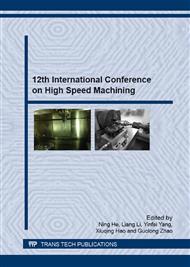[1]
Lutjering G, Williams J. Titanium. Springer, Berlin: (2003).
Google Scholar
[2]
Zhu Zhishou, Reaearch and development of advanced new type titanium alloys for aeronautical applications, Aeronautical Science and Technology. 01(2012)5-9.
Google Scholar
[3]
C.H. Che-Haron, A. Jawaid, The effect of machining on surface integrity of titanium alloy Ti6Al4V, Journal of Materials Processing Technology. 166(2005) 188-192.
DOI: 10.1016/j.jmatprotec.2004.08.012
Google Scholar
[4]
Godbole S, The technological trendsetter. Trade magazine for efficient manufacturing. Publish-Industry Verlag, Munich. 9–10(2013).
Google Scholar
[5]
Aspinwall DK, Dewes RC, Mantle AL, The machining of γ-TiAI intermetallic alloys, CIRP Ann Manuf Technol. 54 (2005)99–104.
DOI: 10.1016/s0007-8506(07)60059-6
Google Scholar
[6]
Hou J, ZhouW, Duan H, Yang G, Xu H, Zhao N, Influence of cutting speed on cutting force, flank temperature, and tool wear in end milling of Ti-6Al-4Valloy, Int J Adv Manuf Technol. 70 (2014)1835–1845.
DOI: 10.1007/s00170-013-5433-8
Google Scholar
[7]
Rotella G, Dillon OW, Umbrello D, Settineri L, Jawahir IS, The effects of cooling conditions on surface integrity in machining of Ti6Al4V alloy, Int J Adv Manuf Technol. 71 (2013)47–55.
DOI: 10.1007/s00170-013-5477-9
Google Scholar
[8]
Rotella G, Dillon OW Jr, Umbrello D, Settineri L, Jawahir IS, The effects of cooling conditions on surface integrity in machining of Ti6Al4V alloy, Int J Adv Manuf Technol. 71(2014)47–55.
DOI: 10.1007/s00170-013-5477-9
Google Scholar
[9]
Chang Hao, He Ning, Man Zhonglei, Study on the cutting force and tool wear of milling TC4, Aviation Precision Manufacturing Technology. 39 (2003)30-33.
Google Scholar
[10]
Li Dengwan, Chen Hongtao, Gan Jianshui, Xu Mingheng, Huang Sui, Test study on cutting force in titanium alloy machining, Journal of Guangxi University(Natural Science Edition). 35(2010) 733-737.
Google Scholar
[11]
Jia Xingmin, Li Jianfeng, Sun Jie, Jiang Zhenxi, Study on cutting parameter optimization for milling titanium alloys based on cutting force and vibration characteristics, Machinery Design & Manufacture. 12(2014)204-208.
Google Scholar
[12]
Liu Peng, Xu Jiuhua, Feng Suling, Fu Yucan, Geng Guosheng, Cutting Forces in High Speed Milling of Titanium Alloy with PCD Tool, Journal of Nanjing University of Aeronautics & Astronautics. 42(2010)224-229.
Google Scholar
[13]
Yang Yong, Li Changhe, Sun Jie, Three-Dimensional Numerical Simulation of Cutting Force, Journal of Basic Science and Engineering. 18(2010) 493-502.
Google Scholar
[14]
Yang Shubao, Xu Jiuhua, Fu Yucan, Wei Weihua, Finite Element Research on Cutting Force and Cutting Temperature in Cutting Hydrogenated Ti-6Al-4V Titanium Alloy, Tool Engineering. 45(2011) 27-30.
DOI: 10.4028/www.scientific.net/kem.419-420.789
Google Scholar
[15]
Han Shu, Study on High Speed MQL Turning of Titanium Alloy with Different Coated Tools, Shanghai, Shanghai Jiao Tong University. 2011: 33-38.
Google Scholar
[16]
Oosthuizen GA, Akdogan G, Treurnicht N, The performance of PCD tools in high-speed milling of Ti6Al4V, Int J Adv Manuf Technol. 52(2010) 929-935.
DOI: 10.1007/s00170-010-2804-2
Google Scholar
[17]
Corduan N, Himbart T, Poulachon G, Dessoly M, Lambertin M, Vigneau J, Payoux B, Wear mechanisms of new tool materialsfor Ti-6AI-4V high performance machining, CIRP Ann Manuf Technol. 52(2003)73-76.
DOI: 10.1016/s0007-8506(07)60534-4
Google Scholar
[18]
Engin S,Altina Y, Mechanics and dynamics of general milling cutters, Part I:Helical End Mills. Int. J. Mach. Tools. Manufact. 41(2001)2195-2212.
Google Scholar
[19]
Altina Y,Engin S, Generalized modeling of mechanics and dynamics of milling cutters, Annals of the CIRP. 50(2001)25-30.
DOI: 10.1016/s0007-8506(07)62063-0
Google Scholar
[20]
Chung-Liang Tsai, Prediction of cutting forces in ball-end milling by means of geometric analysis, Journal of Materials Processing Technology. 205 (2008)24-33.
DOI: 10.1016/j.jmatprotec.2007.11.083
Google Scholar
[21]
Szymon Wojciechowski,Pawe Twardowski, Tool life and process dynamics in high speed ball end milling of hardened steel, 5th CIRP Conference on High Performance Cutting 2012. (2012)289-294.
DOI: 10.1016/j.procir.2012.04.052
Google Scholar
[22]
Sutter G, List G, Very high speed cutting of Ti–6Al-4V titanium alloy-change in morphology and mechanism of chip formation, Int J Mach Tools Manuf. 66(2013)37-43.
DOI: 10.1016/j.ijmachtools.2012.11.004
Google Scholar


